
Facebook Twitter Instagram YouTube RSS Feed
Written on: December 12th, 2017 in Wetland Animals
by Erin Dorset, DNREC Wetland Monitoring & Assessment Program
Tidal salt and brackish marshes are amazing wetland places that are home to many unique plant and animals—including some really cool wetland birds. Many birds depend on salt and brackish marshes for food, shelter, and nesting areas. Some of these birds are large and easily seen, while others are small and secretive—you many not even know they are there.
Read on to meet some of the amazing birds that use salt and brackish marshes, and next time you’re by the coast, look and listen to see if you can spot some!
These guys are some of the easiest birds to spot in a tidal marsh. They are tall and are bluish-gray overall, and you’ll often see them wading around in the water with their long legs. Their long, spear-like bill helps them catch fish. If you are lucky enough, you may even see one of their rookeries, or breeding areas, during nesting season.
These sparrows are some of the most secretive birds of the salt marshes. They are fairly small and fly low across the grasses, only to quickly disappear within them. When the males sing, their song is so quiet that it sounds almost like a whisper. They like to make their nests on the ground, often under tufts of salt meadow hay (Spartina patens), to hide them from predators. Keep your eyes peeled and your ears open and you might just be lucky enough to spot one of these secretive birds.
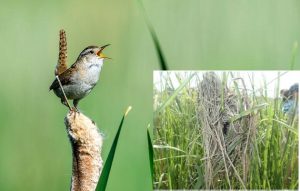
Marsh wren, National Audubon Society, Marsh wren nest, DNREC’s Wetland Monitoring & Assessment Program
You will probably hear these little birds before you see them; although they are small, they have a loud and bubbly song, and they certainly aren’t afraid to sing it! Their little brown bodies blend in with the tall grasses of brackish marshes that they like to perch on, often with each leg on two different grass blades. Their nests are off of the ground and are weaved out of grass pieces, creating a sort of elevated basket with a side entrance.
Clapper rails are much larger than salt marsh sparrows, but they are still pretty secretive. Their call is a loud “kek kek”, and you’ll often hear it when planes startle them. They are often hidden in salt marsh grasses, but they do come out to muddy or shallow water areas to feed on crustaceans and small fish. They make their nests out of marsh grasses on the ground, and the nests can be tricky to find.
Willets are light grayish-brown birds with bright white marks on their outspread wings. They feed on insects and crustaceans in marshes, mudflats, and along beaches. They make their nests in salt marshes out of grasses, and the nests blend in very well with their surroundings. Their call is often very loud, particularly when they feel their nest is threatened.
Great egrets are pretty easy to spot in marshes due to their relatively large size and their bright white color. They use their large bill to catch fish as they wade around in mud and shallow waters. Like great blue herons, they nest in colonies. You may also see snowy egrets in the marshes, which are similar in appearance. The tricks to tell them apart are that great egrets have yellow bills and black legs and feet, while snowy egrets are smaller in size, have blackish bills, and have black legs with yellow feet.
Osprey are birds of prey that are smaller than the bald eagle, and catch fish right out of the water with their sharp talons. They like to fly over marshes looking for fish in nearby waters, and will often hover in one spot when they think prey is near. Osprey like to nest on tops of dead trees, but they will also readily nest on man-made nesting platforms in salt marshes. Their nests are made of many sticks and are very large and visible, so keep a look out and you might find one.
As you have learned, birds that you see here, and many others, rely on salt and brackish marshes for survival. Unfortunately, many of them are facing trouble as climate change, rising sea levels, and human disturbance negatively affect their nesting and feeding wetland habitat. It’s up to people like you to spread the word to help them and their habitats!
The great news is, there are amazing online resources out there to learn more detailed information about these and other coastal marsh birds and the dangers they are facing from habitat changes. You can even become a citizen scientist and record your bird observations for scientists to use to help these birds out. Here are a few wonderful resources to learn more, have fun, and participate in marsh bird conservation:
Written on: December 12th, 2017 in Outreach
by Alison Rogerson, DNREC’s Wetland Monitoring & Assessment Program (aka Delaware Wetlands)
Curious as to what Delawareans think about wetlands? In September of this year we polled 600 Delaware residents across our three counties to find out. We wanted to see if people knew what wetlands are, their benefits, if they think they are good or bad, and where they are getting information about the environment.
Based on the results we came up with ten Delaware Wetlands New Year’s Resolutions to help guide our program into the future. Hey, the survey finding might even help inform your program’s activities too. We are excited to get started!
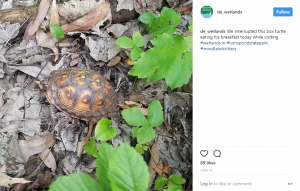 Contrary to the old myth that wetlands are a wasteland 7 out of 8 people reacted positively that wetlands provide wildlife habitat.
Contrary to the old myth that wetlands are a wasteland 7 out of 8 people reacted positively that wetlands provide wildlife habitat.
Nearly half of survey participants said they never get outside to hike, birdwatch, hunt, fish or kayak.
An astounding number of people (85%) felt familiar with the term wetland and could provide some sort of definition!
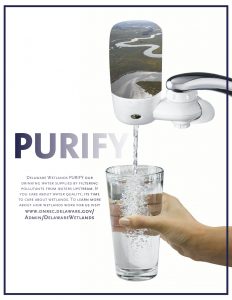 Talk more about a wetlands importance in improving water quality in Delaware’s creeks, rivers and bays.
Talk more about a wetlands importance in improving water quality in Delaware’s creeks, rivers and bays.3 out of 5 people in Delaware think water pollution is a somewhat or very serious problem.
Only half the residents surveyed thought it is a good thing to have a wetland near where they live. There were misconceptions that having a wetland near them would increase flooding.
4 out of 7 people don’t think a wetland exists within a mile of them. Yet 1/4 of Delaware’s land area is wetlands, so they are around every corner!
According to this survey, people are most likely to trust DNREC, the Division of Parks and Recreation, and the University of Delaware Cooperative Extension with information about the natural environment.
75% of survey takers live on less than an acre of land.
Polled citizens are more likely to use a website to find information than social media or printed publications (mailers or newspaper).
For more information about the Delaware Wetlands Survey please contact brittany.haywood@delaware.gov.
Written on: December 12th, 2017 in Wetland Assessments
Guest Writer: Tom McKenna, University of Delaware
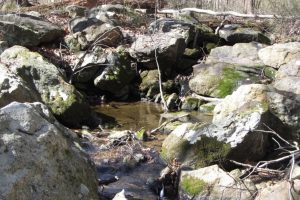
Figure 1a. Spring on a perched floodplain along a tributary of White Clay Creek. a. visual image. Photo Credit: Tom McKenna, UD
Groundwater discharge areas are common hydrologic features in Delaware’s Piedmont Province, located in hilly northern New Castle County. Discharge occurs as springs or seeps. (A seep can be described as simply a spring with discharge through the very small openings between soil or sediment grains. In reality it is a continuum between the two terms). Some are subaqueous features, meaning that groundwater discharges directly to surface water, like a creek. Other seeps and springs are subaerial, so groundwater discharges to the land surface.
Subaerial discharge is often associated with seep or spring wetlands. One unique type of these is the Piedmont Stream Valley Wetlands that are habitats for rare plant species and the federally threatened bog turtle (Bill McAvoy, DNREC). In some places, the springs and seeps are also likely to be conduits for nutrients like nitrogen and phosphorous that result in creeks being “impaired water bodies” (as determined by DNREC and EPA).
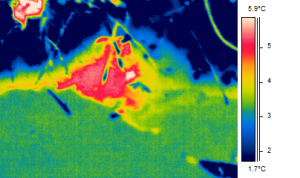
Figure 1b. A thermal image. Spring on a perched floodplain along a tributary of White Clay Creek. Temperatures are “apparent” temperatures as the radiation imaged is a function of the observation angle, reflected temperature from surrounding objects and a property of the object call the emissivity. The temperature for the water is close to the true kinetic temperature as the imager is set to image water with local reflected temperature taken into account. A small wetland (<20 m2) exists downstream of this spring.
Understanding the flow of groundwater that discharges to these creeks and wetlands is difficult because we have a poor knowledge of the distribution of rock fractures that control groundwater flow patterns. The fractured rocks are typically overlain by a 0 to 50-meter-thick regolith that hides the fractures.
One way to gain insight into these groundwater flow systems is to work backward in the groundwater flow system by first locating discharge at seeps and springs (groundwater outcrops*). To address this issue, I am identifying spring and seep locations in the White Clay Creek (Figures 1a and 1b) and other Piedmont watersheds (Figure 4) by conducting walking in-stream surveys with a thermal-imaging camera (Scientifically, it is known as a thermal imaging focal-plane radiometer).
The surveys are typically done on cold mornings in winter between 5 and 10 am. Springs are identified based on the temperature difference between water emanating from the spring (warmer in winter) and the ambient water or land surface (colder in winter). Direct measurements of temperature and specific conductivity are made and GPS coordinates are recorded.
Initial studies clearly indicate that springs are commonly found in the tributaries of White Clay Creek (e.g. higher-order streams), but are not common in the main stem of the White Clay Creek in Delaware and southern Chester County, PA.

Figure 4. Freshwater Marsh, Brandywine Creek State Park on cold morning in winter This set of images shows how heat can be used as a tracer of hydrologic processes. a. visual image. Water was everywhere under the grass and flow was not visually evident. b. thermal image. Relatively warm water is flowing in very shallow channels obscured by the dense, matted vegetation. The temperature difference between dark purple and yellow colors is about 10 degrees C.
* The mapping of “groundwater outcrops” was developed in Alberta, Canada by József Tóth and Peter MeyBoom in the early 1960s (references below). The insights gained by Tóth resulted in his classic paper with illustrations published in every hydrogeology textbook. The paper also earned Tóth the highest award (Meinzer Award) given by the Hydrogeology Division of the Geological Society of America in 1963. He was the first recipient in 1965. The technique and term have fallen away in the literature but its validity still holds true.
Meyboom, P., 1966. Groundwater studies in the Assiniboine River drainage basin: Part I: The evaluation of a flow system in South Central Saskatchewan: Geol. Survey of Canada, Bull. 139, Ottawa, 65 p.
Toth, J., 1963, A theoretical analysis of groundwater flow in small drainage basins, Journal of Geophysical Research, 68(16,) 4795-4812.
Written on: December 11th, 2017 in Wetland Restorations
Guest Writer: Susan Guiteras, USFWS
If you have an interest in Delaware wetlands, chances are you’ve heard about the management challenges and subsequent tidal marsh restoration at Prime Hook NWR, near Milton. For many years, two large areas encompassing about 4000 acres of the refuge were managed as freshwater impoundments.
Beginning in 2006 a series of storms created overwashes and large breaches along the shoreline that separated the managed impoundments from the Delaware Bay, flooding them relentlessly with saltwater. Hurricane Sandy was the final blow to the system, which had suffered rapid peat collapse and widespread conversion to open water.
There were several years of careful discussions and difficult planning as the refuge worked out a long-term strategy to ultimately restore the impounded wetlands to their historic tidal marsh condition.
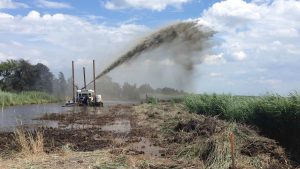
Dredges sprayed mud onto mudflat and open water at the Prime Hook National Wildlife Refuge. Photo Credit: USFWS
The restoration of the refuge wetlands was made possible by federal money through the Hurricane Sandy Disaster Relief Act, and was the largest tidal marsh restoration project ever in the east. Sand dredged from an offshore borrow area was pumped in to close the large breaches and restore the the dune, beach, and backbarrier along more than 8000 linear feet of shoreline. Nearly 60 acres in the back barrier was planted with Panicum and Spartina grasses. Within the marsh interior, more than 20 miles of tidal channels were dredged, mostly following historic drainage patterns. The dredged material was sprayed onto the adjacent area, providing on-site disposal and giving marsh elevation a boost in those areas.
The Seeds of Success program collected seeds representing a mix of 17 species suited to varying conditions, which were spread from an airplane onto large portions of the mudflats in the marsh interior to give revegetation a boost. The restoration work started in the summer of 2015 and moved at a rapid pace. Although the refuge continues to work with partners such as DelDOT and the DNREC Mosquito Control Section on small hydrological alterations in the marsh, the restoration work was largely completed by summer 2016.
As soon as the wetland management challenges began, the refuge formed a critical partnership with the DNREC and the Delaware National Estuarine Research Reserve to begin monitoring water levels and salinity throughout the system, data that was later used in hydrodynamic modeling to guide restoration planning.
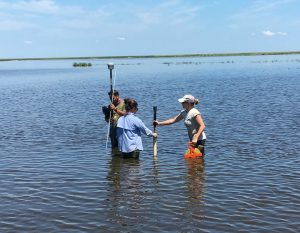
Monitoring an open water site at Prime Hook NWR with an RTK GPS, and slide hammer for soil bearing capacity. Photo credit: USFWS
As a plan for marsh restoration came together, this water monitoring network was expanded and became the basis of a comprehensive biological and abiotic restoration monitoring program. The refuge added additional partners to the effort, including the DNREC Wetland Monitoring and Assessment Program, the University of Delaware College of Earth, Ocean, and Environment, and the Saltmarsh Habitat and Avian Research Program (SHARP), also based at the University of Delaware – among others. In the years prior to, during, and immediately following restoration, these partners have worked with the refuge to collect data on everything from vegetation communities and birds to marsh elevation, sediment concentration in the water, and nutrients.
Now that the restoration has been mostly complete for more than a full growing season, some exciting recovery is evident already!
Although it may take some time for the bird and fish communities to fully respond, the newly-restored beach immediately attracted horseshoe crabs and even nesting piping plovers, least terns, and American oystercatchers. In 2015, the refuge hosted its first ever piping plover nest, and in 2016 there were 6 nests that successfully fledged 12 young birds.
However, the most dramatic evidence of restoration success so far has been the recovery of tidal marsh vegetation throughout the project area. The USFWS, SHARP team, and DNREC partners have monitored vegetation recovery with a combination of remote sensing analysis, basic ground surveys, and in-depth data collection that includes biomass and elevations. Some highlights from initial post-restoration monitoring results include…
But, it is very basic data collection – photography – that has captured the initial progress in the most compelling way. Although open water still dominates in large sections of the wetlands as marsh recovery continues, the transformation is nothing short of dramatic in many areas, as evident in the comparison photos.
What started as open water in 2015, before restoration began, was transformed into mudflats with colonizing and transitional species in 2016, which then gave way to healthy stands of saltmarsh grasses such as Spartina alterniflora in 2017. Planted areas on the backbarrier quickly filled in with lush stands of Panicum grasses and Spartina patens. The intensive monitoring of the project will continue with the refuge’s team of partners for at least the next 5 years. Stay tuned for future updates!
Written on: September 19th, 2017 in Wetland Assessments
You may already be aware that saltwater wetlands are influenced by ocean tides, and that freshwater wetlands located further inland are not influenced by tides.
But, did you know that there are freshwater wetlands that are actually still influenced by the ocean’s tides?
These wetlands, commonly called tidal freshwater wetlands, are in some ways similar to other wetland types. For example, tidal freshwater wetlands provide many of the same services that other wetland types provide, including floodwater storage, improvements to water quality, and wildlife habitat.
Tidal freshwater wetlands also experience some of the same problems that other wetland types experience, including the presence of invasive species like the common reed (Phragmites australis), and the presence of development or agriculture in the area surrounding the wetland.
However, tidal freshwater wetlands are also different in many ways from other wetland types. Though not an all-inclusive list, here are two big ways that tidal freshwater wetlands differ from their other wetland counterparts:
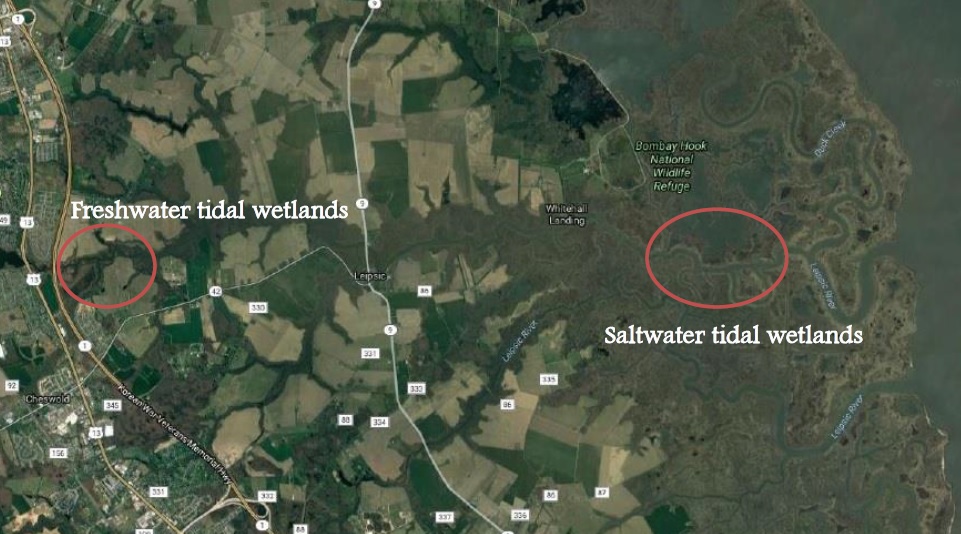
Shown above is an aerial view of the Leipsic River in Kent County, Delaware. Circled in red on the left is an example of an area with tidal freshwater wetlands, and circled in red on the right is an example of an area with saltwater tidal wetlands. Notice that the freshwater tidal wetlands are further upstream (i.e., further from the Delaware Bay, inland) than saltwater wetlands.
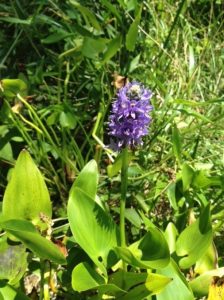
This flowering plant is pickerelweed (Pontedaria cordata), a common plant found in both non-tidal and tidal freshwater wetlands but not in salt marshes.
Plant Community: Tidal freshwater wetlands tend to have a lot of the same plant species as non-tidal freshwater wetlands, such as arrow arum (Peltandra virginica), annual wild rice (Zizania aquatica), big cordgrass (Spartina cynosuroides), water smartweed (Polygonum punctatum), pickerelweed (Pontedaria cordata), broadleaf arrowhead (Sagittaria latifolia) and spatterdock (Nuphar species); however, these plant communities differ greatly from those found in salt marshes. Smooth cordgrass (Spartina alterniflora) or saltmeadow cordgrass (Spartina patens) commonly dominates salt marsh communities, whereas they are often completely absent in tidal freshwater wetlands. Additionally, tidal freshwater wetlands usually have much more plant diversity than salt marshes, meaning that there tends to be a higher number of species present in tidal freshwater wetlands compared with salt marshes.
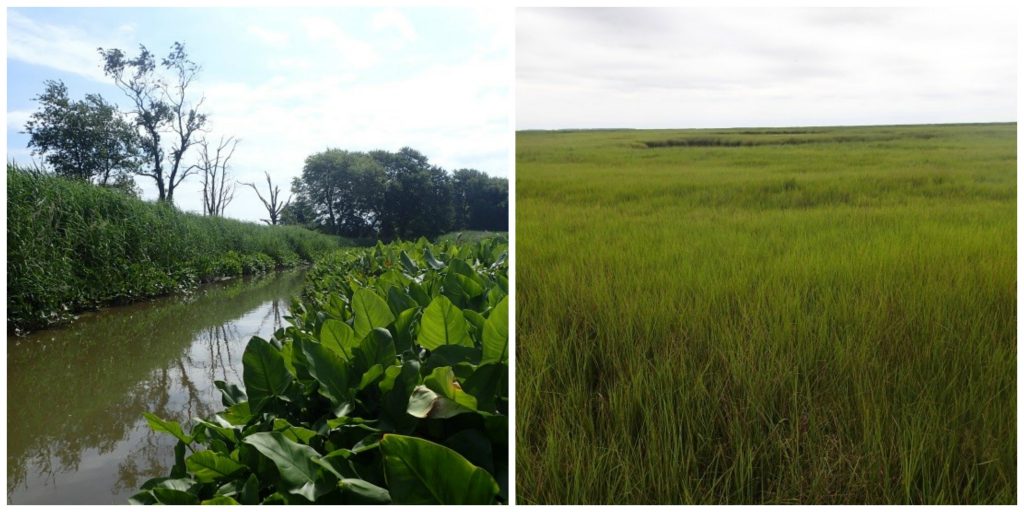
These two pictures show the contrast between common plant communities in Right: A salt marsh (Leipsic River watershed, summer 2013), and Left: A tidal freshwater marsh (Red Lion watershed, summer 2017).
Now that you know a little bit about these wetlands, your next question might be: do we, WMAP, assess the condition of tidal freshwater wetlands in Delaware? Our answer: Yes!
Throughout this summer (2017), we have been assessing wetlands in the Red Lion watershed in New Castle County. Many of our tidal wetland sites thus far have been freshwater tidal wetlands. We can determine if a site is a freshwater or saltwater tidal wetland by measuring the salinity of the water, looking at the plant community, and looking at its position in the landscape using aerial photos.
To learn more about other wetland types that we have in Delaware, visit the Delaware Wetlands website and our blog post about Delaware’s Unique Wetlands.
Written on: September 19th, 2017 in Wetland Animals
Did you know that Delaware has multiple species of crayfish? While crayfish may look like small lobsters, they are actually distant cousins. The most differentiating feature is that lobsters live in saltwater, and crayfish, crawfish, crawdads, or whatever you would like to call them, live in fresh to brackish waters.
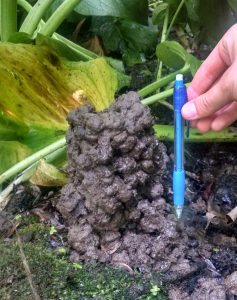
This crayfish chimney is the entrance to the crayfish’s underground tunnels. Depending on the species, there may be multiple chimneys or entrances.
Some crayfish species living in Delaware are naturally occurring here (native), while some come from other parts of the country (invasive), and they all come in various colors and sizes. You are likely to find these crustaceans in flowing streams, lakes, swamps, ponds, and seasonally wet wetland habitats. They live their lives safely burrowed in underground tunnels or hiding out in open water, or some combination of the two. Fun fact, as long as the crayfish’s gills stay moist, it can breathe on land or in the water.
Crayfish are opportunistic feeders using the two antenna on the top of their head to seek out the chemicals that “smell” most tasty to them. They will chow down on decomposing plant or animal parts, slow moving macroinvertebrates such as snails, underwater grasses, amphibians, and fish eggs. Interestingly enough though, juvenile crayfish seem to prefer a diet consisting of mostly meat, while adult crayfish seem content munching away on plant materials.
On the other hand, crayfish also serve as a tasty treat to bass, snapping turtles, raccoons, and herons, and are used as bait by fisherman to catch fish.
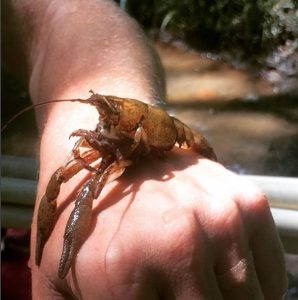
The white river crayfish (Procambarus acutus) is one of a few species that is native to Delaware. They can range in color from pinkish tan to brownish olive and have a broad dark stripe along the abdomen. The claws are slender and have small dark spots. This particular little guy was found dead.
These hard-shelled critters also have interesting behaviors. To escape a predator, they will try to tail flip themselves away. Don’t think they are wimps though, because they aren’t afraid to get down and dirty. Fighting is commonplace among crayfish, whether it be over food, shelter, or selecting the perfect mate. They box, push, grasp, and grab at their opponent until one submits or loses a limb.
But, how does one crayfish know when the other has submitted? Crayfish have developed body language and chemical signals that let their opponent know when they’ve given up. If a crayfish lays its body flat against the ground with its claws forward, or if it does a tail flip and propels itself backwards, it has submitted and the battle is over.
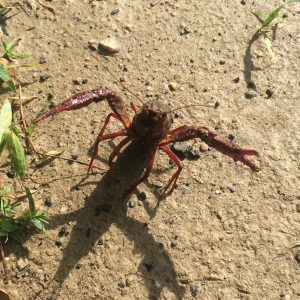
This invasive species of crayfish, the red swamp crayfish (Procambarus clarkii), is found in Delaware.
Crayfish behaviors can vary by species, especially when it comes down to aggression. For example, the red swamp crayfish (Procambarus clarkii) is known for its very aggressive behavior and delicious taste, and it just so happens to be an invasive species right here in Delaware. It uses its aggressive behavior to out-compete native species of crayfish and amphibians for shelter and food.
Native to the U.S.’s Gulf Coast, the red swamp crayfish made its way to Delaware through people releasing or disposing them as unwanted food, pets, or bait. One paper from Indiana hypothesized that flushing crayfish down the toilet was an inappropriate way to dispose of them because they were being found around waste water treatment facilities, “having apparently survived treatment.”
Long story short, crayfish are cool, but the invasive species are bad, and never flush unwanted animals—including crayfish– down the toilet because you never know where they might end up (or what they might turn into).
Red Swamp Crayfish Identification:
• Tolerates a range of salinities and pollution
• Can grow up to 5 inches long
• Dark red in color
• Raised bright red spots on claws and body
• Juveniles are not red and can be difficult to identify
• Have an approximate two year life span in the wild
• If you see one, please report it to the Delaware Division of Fish and Wildlife at 302-735-8655
Resources:
Gherardi, Francesca, and William H. Daniels. “Agonism and shelter competition between invasive and indigenous crayfish species.” NRC Canada, 24 Feb. 2005, pp. 1923–1932.
Jurcak, Ana M, et al. “Behavior of Crayfish.” Biology and Ecology of Crayfish.
“Red Swamp Crayfish (Procambarus Clarkii) Ecological Risk Screening Summary.” U.S. Fish and Wildlife Service, Feb. 2011.
Written on: September 19th, 2017 in Wetland Assessments
Guest Writer: Kari St.Laurent, Delaware National Estuarine Research Reserve
Wetlands are more than just a beautiful photo opportunity. If you are a reader of this blog, you are probably aware that tidal wetlands can protect shorelines from storm surge, reduce nutrients, and provide habitat for critters like shellfish, crabs, and fish. These benefits are collectively known as ecosystem services. Recently, there is another ecosystem service that has been gaining interest from wetland scientists, coastal resources managers, and policy-makers alike – the ability for tidal wetlands to trap and store carbon!
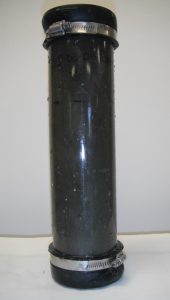
A shallow marsh sediment core from the St. Jones Reserve displays over a foot of carbon-rich marsh sediment.
Tidal wetlands can store mass amounts of carbon within its thick layers of sediment. Plants, including Spartina alterinflora, take in atmospheric carbon dioxide during photosynthesis and turn it into part of their cellular structure. When these marsh plants die, that carbon can be buried into the marsh sediment where it can stay trapped as organic matter for millennia. Organic matter can also be deposited onto a marsh by tides and water coming off from land. This process of carbon going from the atmosphere into marsh plants and sediments is called carbon sequestration.
One key feature of a tidal marsh is its ability to accrete, or be able to vertically build-up sediment to keep pace with local sea level changes. As this layer of marsh sediment gets deeper and deeper, it becomes harder for this trapped carbon to get released back into the atmosphere. Thus, marshes can be a sink for carbon dioxide!
This storage of carbon within tidal wetland ecosystems has earned the name blue carbon. Impressively, tidal wetlands can store more carbon per area than a forest because of its deep layers of mud – measured as deep as 32 feet in Belize. And that carbon in a tidal wetland can be stored for 1000’s of years while systems like a rainforest store carbon for shorter periods, such as decades to centuries. This makes blue carbon an important component of the global carbon cycle.
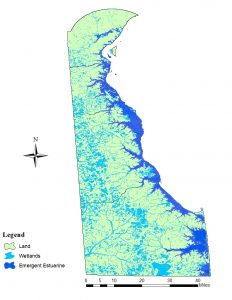
Approximately 23% of Delaware’s wetlands are emergent estuarine, which equates to about 73,000 acres.
Healthy marshes will continue to trap and store carbon, in addition to providing valuable habitat, protection from storms, and natural filtration of nutrients. However, when marshes are lost or degraded, that carbon storage benefit is lost – and even more, that previously stored carbon can be released back into the environment. The protection and restoration of wetlands is a great way to help continue carbon sequestration and storage within tidal wetlands.
So just how much carbon is sequestered each year within Delaware’s approximately 73,000 acres of tidal wetlands? This past summer, DNREC-Delaware Coastal Programs hosted Bryce Stevenosky, a DENIN intern from the University of Delaware, to help us understand this question using published scientific literature. While this is just a back-of-the-envelope type of estimate, it starts to put the amount of blue carbon into perspective for Delaware’s wetland scientists.
Bryce estimated the amount of carbon sequestered each year into Delaware’s marsh sediments is 57,000 metric tons of carbon dioxide. To put this into perspective, the average car emits 4.7 metric tons of carbon each year. This means that Delaware’s wetlands sequester the emissions of over 12,000 cars each year. That’s greater than the population of Smyrna!
This estimate is just the beginning for Delaware’s coastal resources managers and scientists to understand the role wetlands play in storing carbon dioxide, and what we could stand to lose if wetlands are lost. More work needs to be done in Delaware to understand these complex processes and put a site-by-site specific value on just how much carbon Delaware’s tidal wetlands are trapping for us.
Written on: September 13th, 2017 in Wetland Restorations
Guest Writer: John G. Cargill, IV, DNREC Division of Watershed Stewardship/Division of Waste and Hazardous Substances
The National Vulcanized Fiber (NVF) plant located in Yorklyn, Delaware has a rich history with humble beginnings in grist, snuff, lumber, and cotton. By the mid 1800s, production in the valley shifted to paper, and by the early 1900s shifted again to vulcanized fibre. Due to the early success of fibre production, the local Marshall Brothers Company expanded into the National Fibre and Insulation Company and later into the NVF Company. Operations at NVF between 1960 and 2003 were busy. The main mills and the Marshall Brothers Mill were operated 24 hours a day, 7 days a week, moving approximately 40-41 million pounds of material annually. Eventually demand and production slowed, and by 2008 the staffing and traffic of the mills had reduced to about ¼ of the totals from the height of the company. By 2009, the NVF Company had declared bankruptcy and shut down the facility for good.
At the same time that NVF operations were winding down, the Department of Natural Resources and Environmental Control’s (DNREC) Division of Parks and Recreation (Parks) was acquiring land in and around the valley. By the end of 2008, Parks was managing 192 acres of valuable conservation and cultural resource lands known as Auburn Heights Preserve (which also includes the original Marshall family mansion and its steam car museum) and another 121 acres known as the Oversee Farm. Between the two areas of conservation land, and adjacent to the Red Clay Creek, was the former NVF Company plant. Here’s where things get interesting…
Concerns and interest in the NVF properties were far reaching. DNREC’s Division of Waste & Hazardous substances was concerned about hazardous materials and unknown environmental issues; DNREC’s Division of Water Resources was concerned about known impacts to aquatic life in the Red Clay Creek from plant operations; DNREC’s Division of Soil and Water Conservation was focused on historic flooding problems and the hazards posed by an abandoned facility in the flood plain; DNREC’s Division of Parks and Recreation saw an opportunity to connect its other properties in the valley; private investors were interested in the redevelopment potential of creek-side property; and the surrounding community was concerned about all of it. So now what ?
Working as a unit, DNREC put together a multi-divisional working group that began to secure the site and gather information about environmental conditions at the site. DNREC Parks worked with a private investment group to acquire the 119 acres of NVF Company land from the Bankruptcy Trustee, and soon after negotiated rights to various parcels for future Park related development and connection of existing Park amenities. Through this unique partnership, DNREC assumed responsibility for the assessment and environmental cleanup of the former plant properties, while the private developer took responsibility for all asbestos abatement and demolition of existing unwanted structures.
Fast forward to August 2017. All of the structures that will not be redeveloped have been demolished. The feasibility study conducted to determine the best cleanup options for contaminated portions of the property has been, more or less, implemented and completed. Aside from the continuously operating groundwater remediation system that keeps dissolved zinc in groundwater from entering the Red Clay Creek, the most aggressive and costly portion of site remediation entailed zinc source removal (from soil) and creation of a 2-acre wetland to serve as flood water storage capacity.
During the excavation project, over 170 tons (340,000 pounds) of zinc was removed from the soil beneath the former manufacturing facility. In addition, between 500 and 700 pounds of zinc are recovered monthly from the groundwater through the operation of the treatment system.
The majority of non-permeable surfaces have been removed from the site to foster better drainage, and more wetland projects are planned on DNREC owned properties in the valley for additional flood water storage capacity. Finally, pervious paving materials will be used in all roads and parking lots associated with future site redevelopment.
Hazardous Substance Cleanup Act (HSCA) funds have supported approximately $4.5M of the assessment and cleanup efforts, with another $3M on loan from the Clean Water Loan Fund for the zinc source removal/floor mitigation wetland project. Additional State funding is provided to DNREC Parks for ongoing development of trails and other area amenities. At this point in time, the former plant site is ready for additional development, both commercial and/or residential.
Moving forward, the Wilmington and Western Railroad steam train will continue to run through the valley as it always has, but a new turntable and a train station will be added to the former NVF Company property to improve public access to services and amenities. Miles of hiking trail will be accessible from this centralized location, including three historic bridges that will cross the Red Clay Creek within the valley.
An outdoor amphitheater is planned to serve the Delaware Symphony Orchestra as their summer concert home, and residential redevelopment is being planned for one of the former mill building sites (including a stream restoration project along Yorklyn Road).
Public water and sewer are currently being extended to the site to support these and other amenities, including restaurants and shops, that will inevitably follow as the realization of this unprecedented partnership between public and private entities for renewal and revitalization of the Auburn Heights/Yorklyn Valley area are realized.
Written on: May 24th, 2017 in Beneficial Use
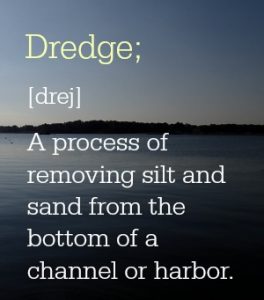 What is one way to give a marsh a lift with the challenge of rising seas? Spray the muddy material that has been dredged up from the bottom of a creek in a thin layer on top of the marsh. But how much mud is too much, and can the plants survive? These are a couple of the questions we (Wetland Monitoring & Assessment Program) set out to answer.
What is one way to give a marsh a lift with the challenge of rising seas? Spray the muddy material that has been dredged up from the bottom of a creek in a thin layer on top of the marsh. But how much mud is too much, and can the plants survive? These are a couple of the questions we (Wetland Monitoring & Assessment Program) set out to answer.
In 2013, Pepper Creek in Dagsboro was set to be dredged, so we rallied the troops and came up with a plan to test out how the beneficial reuse of dredge materials (also called thin layer application) affect marshes in Delaware. The resulting spoils from dredging were thinly sprayed over the marsh at the Piney Point Tract of the Assawoman Wildlife Area, and long term monitoring stations were set up.
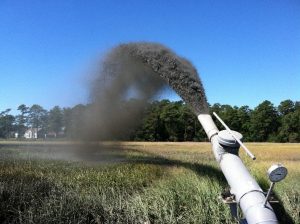
Dredge material being sprayed on marsh surface.
For the past three years we have been looking at how the plant community has responded to the application, and how the marsh surface has changed by performing Real Time Kinematic (RTK) GPS transect surveys of the area and measuring surface accretion with feldspar marker horizon plots.
From the data we have been gathering we’ve figured out a couple of things that work and some things that need further study for future projects:
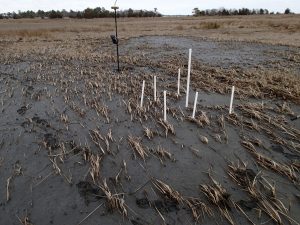
Feldspar assessment plot in a thin layer dredge application area.
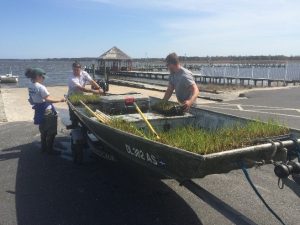
Smooth cordgrass plants on their way to being planted in bare areas of the dredge application area.
Establish a limit to the amount of mud that can be sprayed in the application area. For our area, we suggest approximately 10 to 12 centimeters. The plants in areas that were more thickly sprayed with mud still struggle to grow through the mud. To supplement these thickly applied areas, we planted 2600 smooth cordgrass (Spartina alterniflora) plugs to try and fill in the bare areas. We even started a mini-experiment to see if planting in clumps verses rows allows the little beauts to survive better. We’re still collecting data on the mini-experiment, but hope to have some interesting results soon.
So the nitty gritty of it is that spraying dredge materials on top of a marsh can increase the height of that marsh. But, careful attention must be paid to how thickly the mud is sprayed, and the site should be monitored for problem areas that need replanting.
This project was done in partnership with DNREC’s Shoreline and Waterway Management Section. For more information or questions about this project, please contact Alison Rogerson at alison.rogerson@delaware.gov or 302-739-9939.
Written on: May 24th, 2017 in Wetland Assessments
Coastal wetlands are a hallmark feature of the Delaware’s Bayshore, making up about 23% of all wetland types in the state. Because of the many beneficial services these wetlands provide, such as wave energy reduction, the survival of coastal wetlands is an important part of protecting our seaside communities from threats associated with the changing climate.
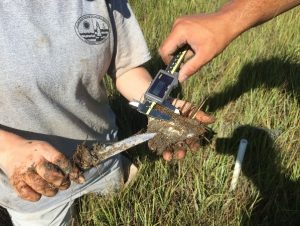
Measuring the amount of sediment on top of a feldspar (a type of clay) marker for a SSIM site.
We here at DNREC’s Wetland Monitoring & Assessment Program (WMAP) are doing our part to track changes in coastal marshes with the long-term monitoring of fixed sites in the Christina and Broadkill watersheds.
To do this, we’ve joined in on the Mid-Atlantic Coastal Wetland Assessment (MACWA) method by maintaining Site Specific Intensive Monitoring sites, also called SSIM (pronounced sim). This monitoring effort establishes fixed stations in coastal marshes and looks at a couple of different factors including water quality, soil quality, plant community, and marsh surface characteristics to help determine if that marsh is capable of keeping up with sea level rise.
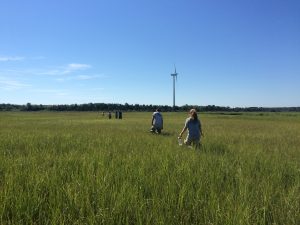
Scientists from WMAP and PDE walking out to SSIM field site to begin monitoring efforts.
There are currently seven fully established SSIM stations in the Delaware Bay Estuary network with two of them residing right here in the little state we call home, Delaware. Two or three times a year, three to four scientists (or scientists in training) slide on their hip boots, head out to the marshes and gather data.
The first SSIM site was installed in Delaware in 2010 on the Christina River in the Russell Peterson Urban Wildlife Refuge. This site is a freshwater site that is impacted by both the past and current chemical industry and from marsh fragmentation caused by the construction of highways in the 1960’s.
The second site in Delaware is located in the Great Marsh Preserve along Canary Creek, an offshoot of the Broadkill River, in Lewes and was installed in 2014. This station is the most downstream location out of the seven in the Delaware Bay Estuary and has the saltiest water of all of the sites because of its proximity to the Atlantic Ocean. The surrounding landscape of this area is agricultural, with some housing communities. Like most salt marshes along the east coast, these areas were historically ditched for mosquito population control.
With each passing year we gather more and more data at these two SSIM sites that will help us understand more about our marshes’ ability to keep up with sea level rise. Be on the lookout for future updates about this project!
This project is done in partnership with the Partnership for the Delaware Estuary (PDE).